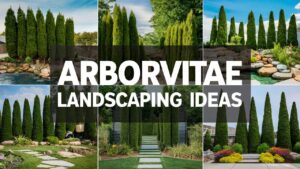Landscaping is an art form that transforms outdoor spaces into visually stunning and harmonious environments. In this comprehensive guide, we will explore a wide range of exceptional landscaping plants that can elevate the beauty and charm of any outdoor setting.
Hydrangeas
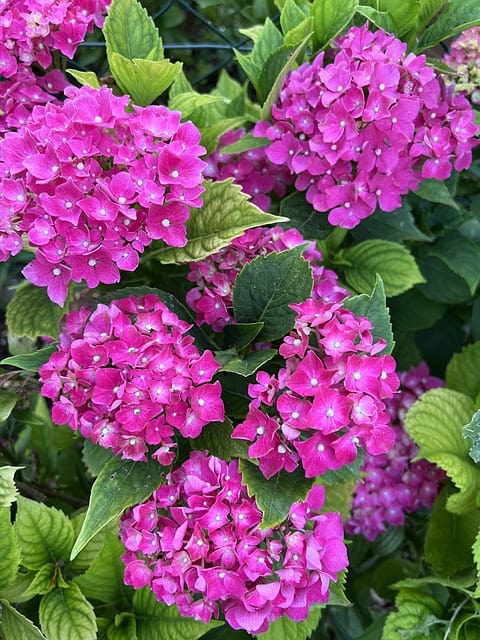
Hydrangeas are beloved for their large, showy blooms that come in a variety of captivating colors, including pink, blue, purple, and white. These versatile plants thrive in partial shade to full sun, making them an excellent choice for a wide range of garden settings. Hydrangeas are known for their ability to adapt to different soil conditions, though they prefer well-drained, acidic soil for optimal growth and bloom production.
One of the standout features of hydrangeas is their ability to change color based on the soil’s pH level. In acidic soils, the blooms will typically appear blue, while in alkaline soils, they will be pink. This unique characteristic allows gardeners to experiment with color and create stunning color schemes within their landscapes.
Hydrangeas come in various forms, from the classic mophead varieties to the more delicate lacecap types. They can be used as focal points, border plants, or even in containers, making them a versatile choice for any outdoor space. Proper pruning and care are essential for maintaining the health and appearance of hydrangeas, ensuring they continue to thrive and provide a stunning display season after season.
Camellias
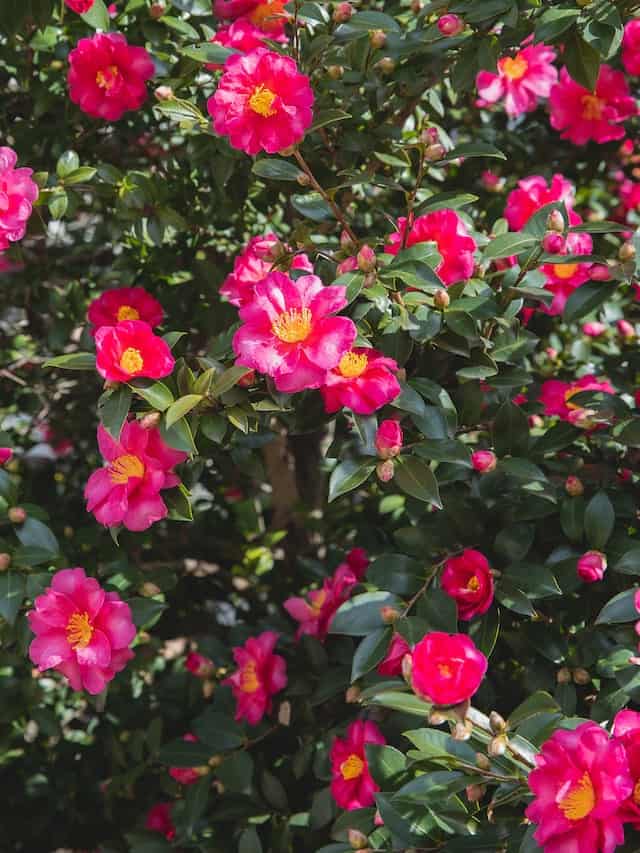
Camellias are evergreen shrubs that boast exquisite, camellia-shaped flowers in a range of colors, including white, pink, red, and even variegated varieties. These plants are known for their ability to bloom during the cooler months, providing a welcome burst of color when many other plants are dormant.
Camellias thrive in partial shade to full shade, making them an excellent choice for areas with limited sunlight exposure. They prefer well-drained, acidic soil and can tolerate a wide range of soil types, from sandy to clay-based. Proper mulching and regular watering are essential for maintaining the health and vigor of camellias.
One of the unique features of camellias is their versatility in the landscape. They can be used as foundation plantings, hedges, or even as specimen plants, showcasing their stunning blooms. Camellias also make excellent container plants, allowing gardeners to enjoy their beauty in small spaces or on patios and balconies.
Viburnum

Viburnum is a diverse genus of shrubs that offer a wide range of benefits to the landscape. These plants are known for their clusters of fragrant, showy flowers that bloom in the spring, followed by the production of colorful berries that attract a variety of birds and wildlife.
Viburnums come in a variety of sizes, shapes, and growth habits, making them suitable for a range of landscape applications. From the compact, rounded forms to the taller, more upright varieties, there is a viburnum to fit any garden design.
One of the standout features of viburnums is their ability to thrive in a wide range of soil conditions, from well-drained to heavy clay soils. They can also tolerate partial shade to full sun, making them a versatile choice for various garden settings.
Viburnums are not only visually appealing but also offer practical benefits to the landscape. Many varieties are known for their excellent screening and privacy-enhancing properties, making them an ideal choice for hedges, borders, or foundation plantings. Additionally, their attractive foliage and berries provide year-round interest and contribute to the overall beauty of the landscape.
Azalea (Rhododendron spp.)
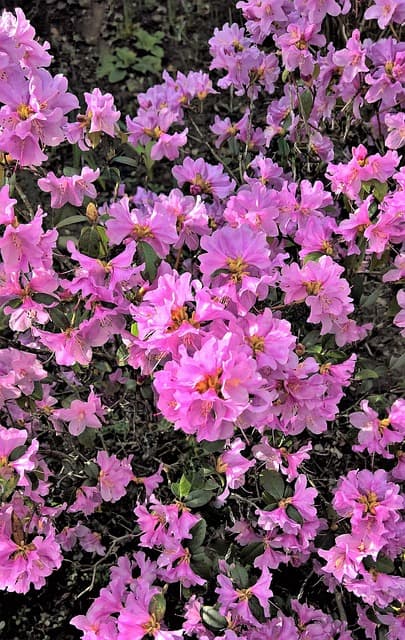
Azaleas, members of the Rhododendron family, are beloved for their vibrant, showy blooms that come in a wide range of colors, including pink, red, white, purple, and even yellow. These evergreen shrubs are a popular choice for landscaping due to their ability to thrive in partial shade to full sun, making them adaptable to various garden settings.
One of the key features of azaleas is their preference for acidic soil, which is essential for their optimal growth and bloom production. They excel in well-drained, humus-rich soils and can be particularly stunning when planted in clusters or as foundation plantings. Azaleas also make excellent container plants, allowing gardeners to enjoy their beauty in small spaces or on patios and balconies.
Azaleas are known for their relatively compact growth habit, making them a versatile choice for borders, hedges, or as specimen plants. Their vibrant blooms typically appear in the spring, providing a burst of color that can be further enhanced by the plant’s glossy, evergreen foliage.
Rose Bushes
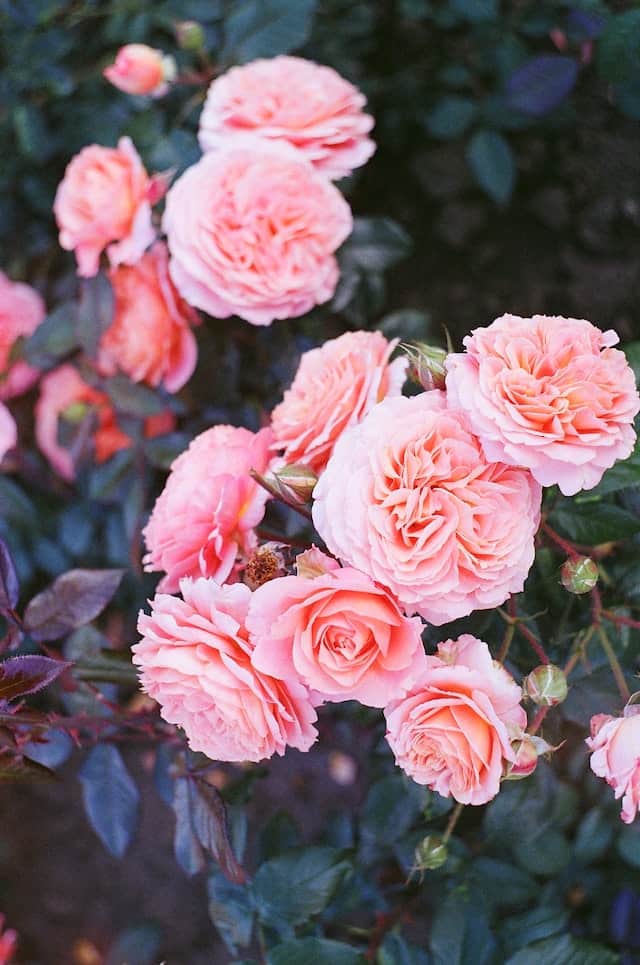
Rose bushes are a classic and beloved addition to any landscaping design. These iconic plants offer a wide range of bloom colors, forms, and growth habits, making them a versatile choice for a variety of garden settings.
From the delicate, fragrant hybrid tea roses to the hardy, disease-resistant shrub roses, there is a rose variety to suit every gardener’s preference. Rose bushes can be used as focal points, border plants, or even trained to climb trellises or arbors, adding vertical interest to the landscape.
One of the key considerations when incorporating rose bushes into a landscape is their sun and soil requirements. Most rose varieties thrive in full sun, with at least six hours of direct sunlight per day. They also prefer well-drained, nutrient-rich soil that is slightly acidic to neutral in pH.
Despite their reputation for being high-maintenance, rose bushes can be a rewarding addition to any landscape, providing a stunning display of color and fragrance throughout the growing season.
Crape Myrtle (Lagerstroemia)
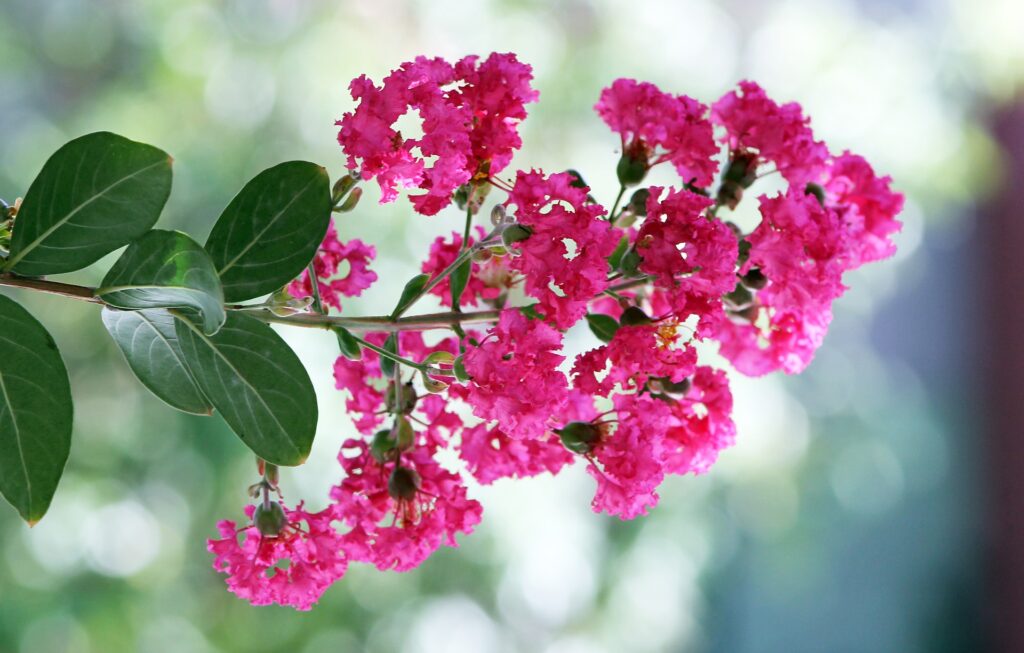
Crape myrtles, also known as crepe myrtles, are a versatile and eye-catching addition to any landscaping design. These deciduous trees or shrubs are renowned for their vibrant, long-lasting blooms that appear in the summer and can last well into the fall.
Crape myrtles come in a variety of sizes, from compact, dwarf varieties to larger, tree-like forms, making them suitable for a range of landscape applications. They can be used as specimen plants, in groupings, or as part of a mixed border, adding a bold and striking visual element to the garden.
One of the standout features of crape myrtles is their exceptional drought tolerance, making them a practical choice for regions with hot, dry summers. They thrive in full sun and can tolerate a wide range of soil types, from well-drained to clay-based soils.
In addition to their stunning blooms, crape myrtles also offer year-round interest through their attractive, exfoliating bark and vibrant fall foliage. The bark can range in color from smooth, light gray to a more textured, cinnamon-colored appearance, adding visual interest even when the plant is not in bloom.
Butterfly Bush (Buddleia davidii)

Butterfly bushes, also known as Buddleia, are a beloved addition to many landscaping designs due to their ability to attract a wide variety of butterflies and other pollinators. These fast-growing, deciduous shrubs are renowned for their long, arching flower spikes that bloom in a range of vibrant colors, including purple, pink, white, and even yellow.
One of the key features of butterfly bushes is their ability to thrive in full sun and well-drained soil. They are particularly well-suited for hot, dry climates and can tolerate a wide range of soil types, from sandy to clay-based. Butterfly bushes are also relatively low-maintenance, requiring minimal pruning and care to maintain their shape and encourage continuous bloom production.
In addition to their appeal to butterflies and other pollinators, butterfly bushes also offer visual interest throughout the growing season. Their lush, green foliage provides a beautiful backdrop for the showy flower spikes, and their arching, graceful habit can be used to create a sense of movement and flow in the landscape.
Butterfly bushes can be used in a variety of landscape applications, from border plantings and mass plantings to specimen plants and container gardens. Their versatility and easy-care nature make them an excellent choice for gardeners of all skill levels.
Fuchsia

Fuchsias are a delightful and eye-catching addition to any landscaping design, offering a unique and captivating display of pendant-shaped flowers in a wide range of colors, including red, purple, pink, and white.
These tender perennials are often grown as annuals in many climates, but they can also be overwintered indoors or in protected areas to enjoy their beauty year after year. Fuchsias thrive in partial shade to full shade, making them an excellent choice for areas with limited sunlight exposure.
One of the standout features of fuchsias is their versatility in the landscape. They can be used as trailing plants in hanging baskets, as accent plants in mixed containers, or as part of a shaded border or foundation planting. Their cascading habit and vibrant blooms create a visually stunning and eye-catching display.
Fuchsias prefer well-drained, nutrient-rich soil and regular watering to maintain their lush foliage and continuous bloom production. They may also benefit from the application of a balanced, water-soluble fertilizer to ensure they receive the necessary nutrients for optimal growth and flowering.
Virginia Sweetspire (Itea virginica)
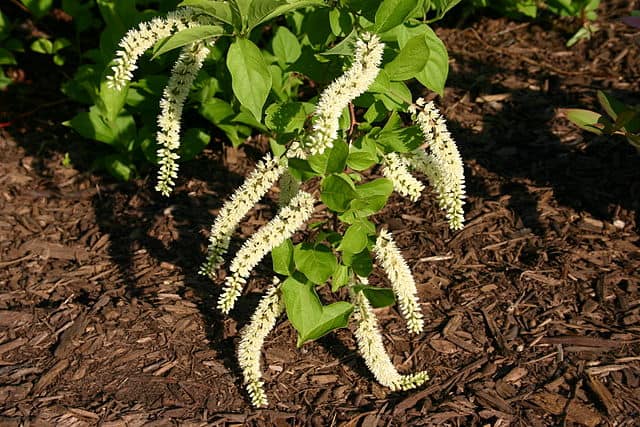
Virginia sweetspire, also known as Virginia willow, is a versatile and underutilized shrub that deserves a place in many landscaping designs. This native North American plant offers a unique and captivating display, with its long, arching flower spikes that bloom in the spring and early summer.
One of the standout features of Virginia sweetspire is its ability to thrive in a wide range of soil conditions, from moist, well-drained soils to heavy, clay-based soils. It is also adaptable to varying light conditions, performing well in partial shade to full sun, making it a practical choice for a variety of garden settings.
In addition to its showy spring blooms, Virginia sweetspire also offers year-round interest through its vibrant fall foliage, which can range from deep red to purple hues. This seasonal color change adds a dynamic and visually striking element to the landscape.
Virginia sweetspire can be used in a variety of landscape applications, from foundation plantings and border gardens to mass plantings and naturalized areas. Its compact, mounding habit and relatively small stature make it an excellent choice for smaller gardens or as an understory plant in woodland settings.
Bottlebrush Buckeye (Aesculus parviflora)
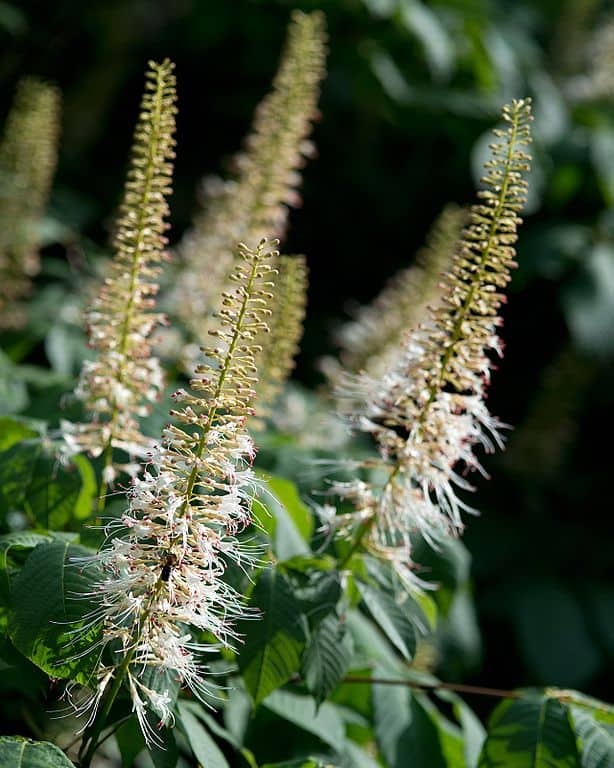
Bottlebrush buckeye is a captivating and unique addition to any landscaping design. This large, deciduous shrub or small tree is known for its striking, bottlebrush-like flower spikes that bloom in the summer, creating a visually stunning display.
One of the key features of the bottlebrush buckeye is its adaptability to a wide range of soil conditions, from well-drained to moist, and its tolerance for partial shade to full sun. This versatility makes it a practical choice for a variety of garden settings, from woodland areas to more formal landscaping designs.
In addition to its showy blooms, the bottlebrush buckeye also offers year-round interest through its attractive, palmate foliage that turns a vibrant yellow or orange in the fall. The plant’s large, rounded habit and multi-stemmed growth pattern can also contribute to the overall visual appeal of the landscape.
Bottlebrush buckeyes are particularly well-suited for use as specimen plants, where their unique and captivating features can be showcased to their full potential. They can also be incorporated into mixed borders or used as a focal point in a larger garden design.
Korean Barberry (Berberis koreana)
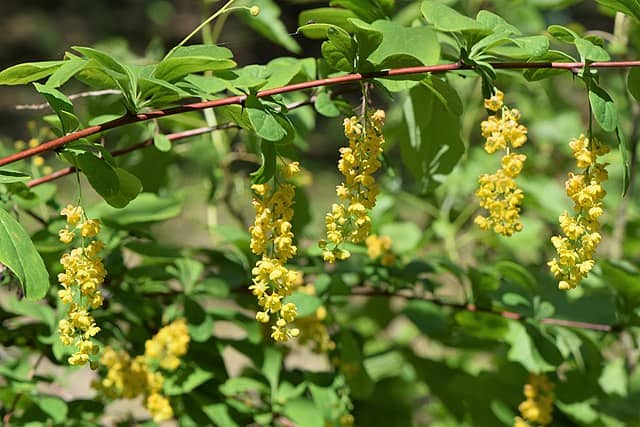
Korean barberry is a versatile and low-maintenance shrub that can be a valuable addition to many landscaping designs. This hardy, deciduous plant is known for its vibrant, multi-season interest, with its striking foliage, thorny stems, and eye-catching berries.
One of the standout features of the Korean barberry is its ability to thrive in a wide range of soil conditions, from well-drained to heavy clay soils. It is also highly adaptable to varying light conditions, performing well in full sun to partial shade, making it a practical choice for a variety of garden settings.
In the spring and summer, the Korean barberry displays its lush, green foliage, which can take on a reddish-purple hue in the fall, adding a dynamic and visually striking element to the landscape. The plant’s thorny stems also provide an effective barrier or hedge, making it a practical choice for security plantings or privacy screens.
As the growing season progresses, the Korean barberry produces clusters of small, yellow flowers that give way to vibrant, red berries in the late summer and fall. These berries not only add visual interest but also provide a valuable food source for birds and other wildlife.
Hummingbird Summersweet (Clethra alnifolia)

Hummingbird summersweet, also known as the sweet pepperbush, is a captivating and versatile shrub that deserves a place in many landscaping designs. This native North American plant is renowned for its fragrant, white or pink flower spikes that bloom in the summer, attracting a variety of pollinators, including hummingbirds and butterflies.
One of the key features of the hummingbird summersweet is its ability to thrive in moist, well-drained soils and partial shade to full sun conditions. This adaptability makes it a practical choice for a range of garden settings, from woodland areas to more formal landscaping designs.
In addition to its showy blooms, the hummingbird summersweet also offers year-round interest through its attractive, glossy foliage that turns a vibrant yellow or orange in the fall. The plant’s compact, mounding habit and relatively small stature also make it an excellent choice for smaller gardens or as an understory plant in mixed borders.
Hummingbird summersweet can be used in a variety of landscape applications, from foundation plantings and border gardens to mass plantings and naturalized areas. Its ability to attract pollinators and provide a source of nectar and pollen makes it a valuable addition to any wildlife-friendly garden.
Dwarf Blooming Lilac (Syringa meyeri ‘Palibin’)
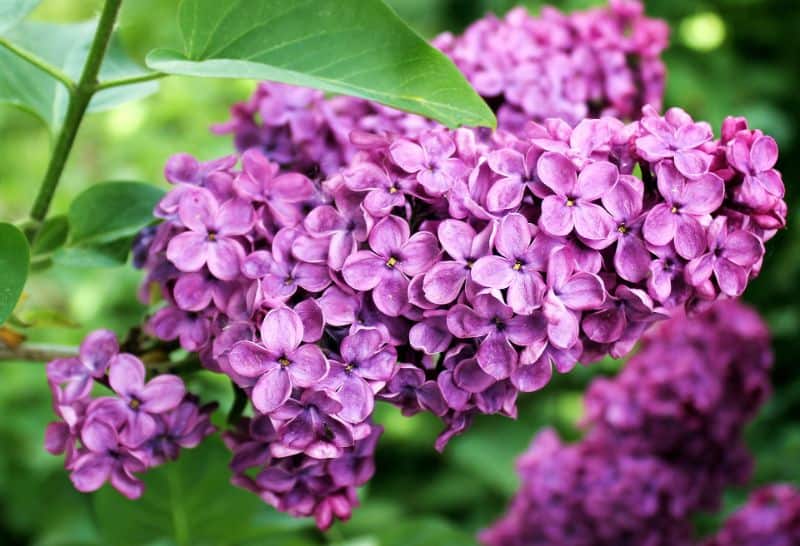
Dwarf blooming lilac, also known as the Palibin lilac, is a compact and versatile shrub that offers a delightful display of fragrant flowers in the spring. Despite its smaller stature, this variety of lilac packs a punch, with its abundant clusters of lavender-pink blooms that fill the air with their signature sweet scent.
One of the key features that sets the dwarf blooming lilac apart is its ability to thrive in a wide range of soil conditions, from well-drained to heavy clay soils. It is also adaptable to varying light conditions, performing well in full sun to partial shade, making it a practical choice for a variety of garden settings.
In addition to its showy spring blooms, the dwarf blooming lilac also offers year-round interest through its attractive, heart-shaped foliage that turns a vibrant yellow or purple in the fall. The plant’s compact, rounded habit and relatively small size make it an excellent choice for smaller gardens, foundation plantings, or as part of a mixed border.
Dwarf blooming lilacs are particularly well-suited for use as specimen plants, where their unique features can be showcased to their full potential. They can also be incorporated into mass plantings or used as a focal point in a larger garden design.
Rose of Sharon (Hibiscus syriacus)
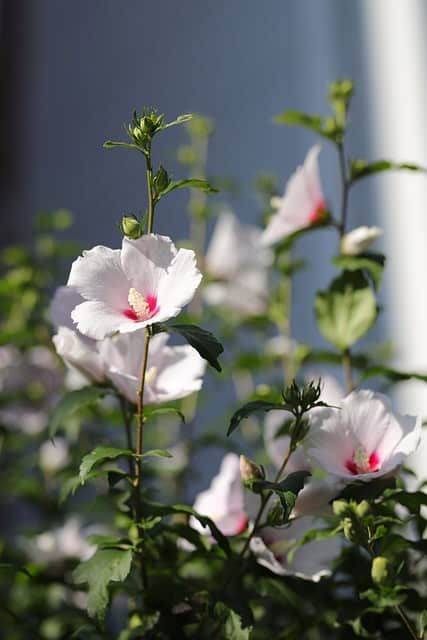
Rose of Sharon, also known as the shrub althea, is a stunning and versatile addition to any landscaping design. This deciduous shrub is renowned for its large, showy flowers that bloom in a wide range of colors, including white, pink, purple, and even red, providing a vibrant and eye-catching display throughout the summer and fall.
One of the standout features of the rose of Sharon is its ability to thrive in a variety of soil conditions, from well-drained to heavy clay soils. It is also highly adaptable to varying light conditions, performing well in full sun to partial shade, making it a practical choice for a range of garden settings.
In addition to its stunning blooms, the rose of Sharon also offers year-round interest through its attractive, green foliage that can take on a reddish-purple hue in the fall. The plant’s upright, multi-stemmed habit and relatively large size make it an excellent choice for use as a specimen plant, in mixed borders, or as part of a privacy screen or hedge.
Rose of Sharon is particularly well-suited for gardeners who are looking to attract pollinators, as its nectar-rich flowers are a magnet for hummingbirds, butterflies, and other beneficial insects. This makes it a valuable addition to any wildlife-friendly garden.
Common Ninebark (Physocarpus opulifolius)
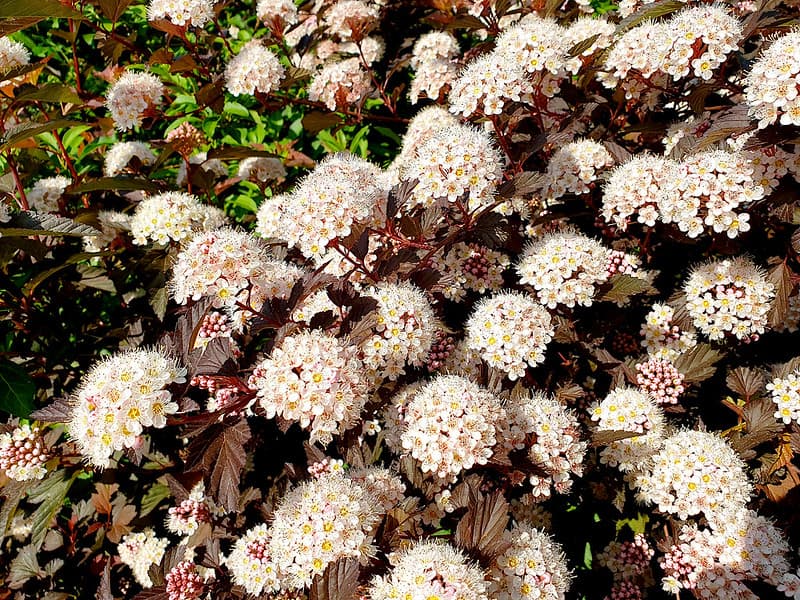
Common ninebark is a versatile and eye-catching shrub that deserves a place in many landscaping designs. This native North American plant is known for its striking, multi-season interest, with its vibrant foliage, exfoliating bark, and clusters of white or pink flowers.
One of the standout features of the common ninebark is its ability to thrive in a wide range of soil conditions, from well-drained to heavy clay soils. It is also highly adaptable to varying light conditions, performing well in full sun to partial shade, making it a practical choice for a variety of garden settings.
In the spring and summer, the common ninebark displays its lush, green foliage, which can take on a reddish-purple or bronze hue, depending on the cultivar. As the growing season progresses, the plant produces clusters of small, white or pink flowers that add a delicate and visually striking element to the landscape.
One of the unique characteristics of the common ninebark is its exfoliating bark, which peels away in thin, papery layers to reveal a multi-toned, textured appearance. This feature adds visual interest to the plant throughout the year, even when it is not in bloom.
Purple Ninebark (Physocarpus opulifolius ‘Monlo’)
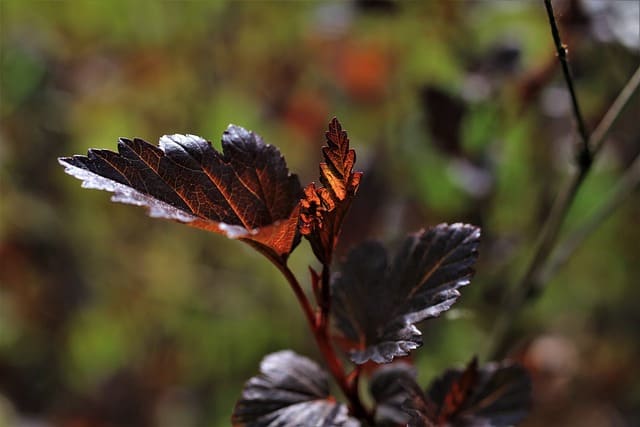
Purple ninebark, also known as the “Diablo” ninebark, is a stunning and versatile cultivar that offers a unique and captivating addition to any landscaping design. This vibrant shrub is known for its striking, deep purple foliage that provides year-round interest and contrast in the garden.
One of the key features that sets the purple ninebark apart is its ability to maintain its rich, purple hue throughout the growing season, even in full sun conditions. This makes it an excellent choice for use as a focal point, in mixed borders, or as part of a cohesive color scheme in the landscape.
In addition to its eye-catching foliage, the purple ninebark also produces clusters of small, white flowers in the spring that add a delicate and visually striking element to the plant. As the growing season progresses, the plant’s exfoliating bark also begins to peel away, revealing a multi-toned, textured appearance that adds further visual interest.
Like its common ninebark counterpart, the purple ninebark is highly adaptable to a wide range of soil conditions, from well-drained to heavy clay soils, and can thrive in full sun to partial shade. This versatility makes it a practical choice for a variety of garden settings, from formal landscaping designs to more naturalistic plantings.
Honeysuckle Shrubs

Honeysuckle shrubs are a beloved and versatile addition to many landscaping designs, offering a captivating display of fragrant, tubular flowers that bloom in a range of colors, including white, yellow, pink, and red.
One of the standout features of honeysuckle shrubs is their ability to attract a variety of pollinators, including hummingbirds, butterflies, and bees, making them a valuable addition to any wildlife-friendly garden. Their nectar-rich flowers provide a valuable food source for these important creatures, while their dense, twining growth habit can also offer shelter and nesting sites.
Honeysuckle shrubs are highly adaptable to a wide range of soil conditions, from well-drained to moist soils, and can thrive in full sun to partial shade. This versatility makes them a practical choice for a variety of garden settings, from border plantings and foundation plantings to arbors and trellises.
In addition to their showy blooms, honeysuckle shrubs also offer year-round interest through their attractive, green foliage that can take on a reddish or purple hue in the fall. Their arching, twining habit also makes them an excellent choice for use as a groundcover or as a spilling element in mixed containers.
Mountain Laurel (Kalmia latifolia)
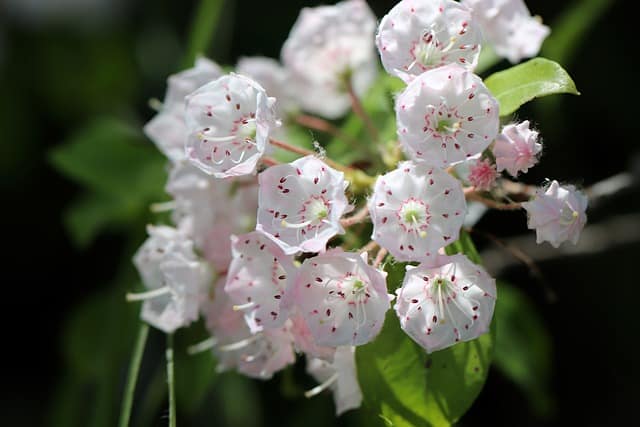
Mountain laurel is a stunning and versatile evergreen shrub that deserves a place in many landscaping designs. This native North American plant is renowned for its showy, clustered flowers that bloom in the spring, offering a captivating display of color and texture.
One of the key features that sets the mountain laurel apart is its ability to thrive in partial shade to full sun conditions, making it a practical choice for a variety of garden settings. It is also highly adaptable to a range of soil types, from well-drained to moist, acidic soils, further expanding its versatility in the landscape.
In addition to its stunning spring blooms, the mountain laurel also offers year-round interest through its attractive, leathery foliage that maintains its deep green hue throughout the seasons. The plant’s compact, mounding habit and relatively small stature also make it an excellent choice for use as a foundation plant, in mixed borders, or as part of a naturalized planting.
Mountain laurels are particularly well-suited for use in woodland gardens or as part of a shaded border, where their vibrant flowers and lush foliage can create a visually striking contrast against the surrounding plants. They can also be incorporated into more formal landscaping designs, where their unique features can
Potentilla Shrubs (Potentilla fruticosa)
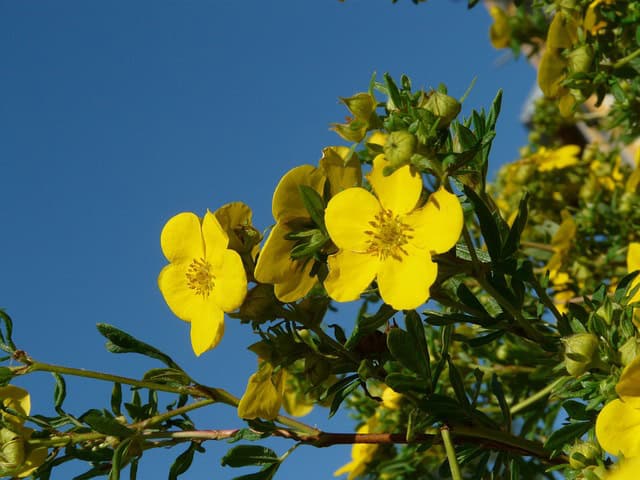
Potentilla shrubs, also known as cinquefoil, are a versatile and eye-catching addition to any landscaping design. These hardy, deciduous plants are renowned for their abundant, colorful blooms that appear throughout the summer and into the fall, providing a long-lasting display of color and texture.
One of the standout features of potentilla shrubs is their ability to thrive in a wide range of soil conditions, from well-drained to moist, and their tolerance for full sun to partial shade. This adaptability makes them a practical choice for a variety of garden settings, from formal landscaping designs to more naturalistic plantings.
In addition to their showy flowers, potentilla shrubs also offer year-round interest through their attractive, green foliage that can take on a reddish or purple hue in the fall. The plant’s compact, mounding habit and relatively small stature also make it an excellent choice for use as a groundcover, in mixed borders, or as part of a rock garden.
Potentilla shrubs are particularly well-suited for gardeners who are looking to attract pollinators, as their nectar-rich flowers are a magnet for bees, butterflies, and other beneficial insects. This makes them a valuable addition to any wildlife-friendly garden.
Winter Creeper (Euonymus fortunei)

Winter creeper, also known as the wintercreeper, is a versatile and hardy evergreen vine that can be a valuable addition to many landscaping designs. This plant is renowned for its ability to thrive in a wide range of soil conditions, from well-drained to moist, and its tolerance for full sun to partial shade.
One of the key features that sets the winter creeper apart is its adaptability to various growing conditions, allowing it to be used in a variety of landscape applications. It can be trained to climb trellises, fences, or walls, providing a lush, green backdrop or accent. Alternatively, it can be used as a groundcover, cascading over retaining walls or spilling from containers.
In addition to its versatility, the winter creeper also offers year-round interest through its attractive, evergreen foliage. Depending on the cultivar, the leaves can range in color from deep green to variegated patterns of green, white, and even purple. This diversity of foliage colors and textures can add depth and visual interest to the landscape.
Winter creepers are particularly well-suited for use in shaded areas or as a groundcover in woodland gardens, where their ability to thrive in partial shade can be an asset. They can also be incorporated into more formal landscaping designs, where their trailing habit and unique foliage can provide a striking contrast to other plants.
European Box Plant (Buxus)
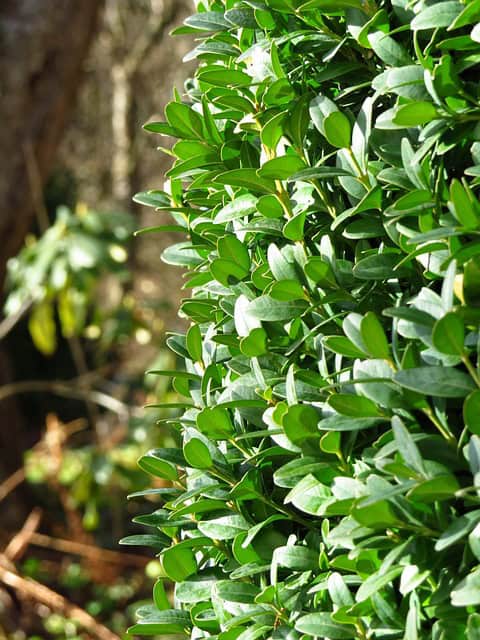
European box plant, also known as the common boxwood, is a classic and versatile evergreen shrub that has long been a staple in many landscaping designs. This compact, slow-growing plant is renowned for its dense, glossy foliage and its ability to be easily shaped and maintained through pruning.
One of the key features that makes the European box plant a popular choice for landscaping is its adaptability to a wide range of soil conditions, from well-drained to heavy clay soils. It is also highly tolerant of varying light conditions, performing well in full sun to partial shade, further expanding its versatility in the landscape.
In addition to its attractive foliage, the European box plant also offers year-round interest through its compact, formal habit, which makes it an excellent choice for use as a low hedge, in formal gardens, or as a border plant. Its small stature and slow growth rate also make it a practical choice for use in containers or as a foundation plant.
European box plants are particularly well-suited for use in traditional, formal landscaping designs, where their precise, manicured appearance can complement the overall aesthetic. They can also be incorporated into more naturalistic plantings, where their evergreen foliage can provide a striking contrast to the surrounding plants
Japanese Laurel (Aucuba japonica)
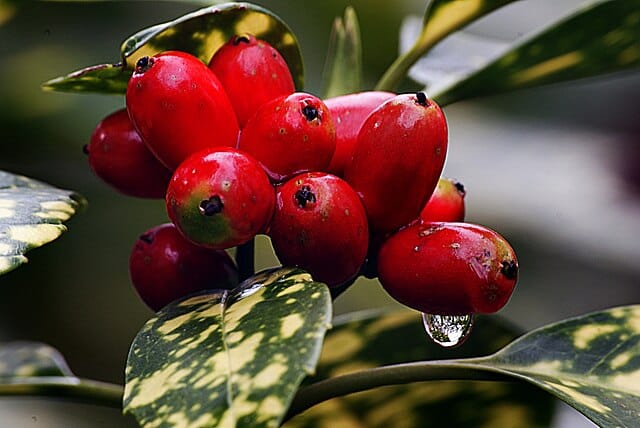
Japanese laurel, also known as the spotted laurel or gold dust plant, is a versatile and eye-catching evergreen shrub that can be a valuable addition to many landscaping designs. This plant is renowned for its distinctive foliage, which can range from deep green to vibrant, speckled patterns of gold and green, depending on the cultivar.
One of the standout features of the Japanese laurel is its ability to thrive in shaded or partially shaded areas, making it an excellent choice for use in woodland gardens, under the canopy of larger trees, or in other areas where light levels may be limited. It is also highly adaptable to a range of soil conditions, from well-drained to moist, clay-based soils.
In addition to its striking foliage, the Japanese laurel also produces small, inconspicuous flowers in the spring, which can be followed by clusters of red berries in the fall. These features, combined with the plant’s compact, mounding habit, make it a versatile choice for use as a foundation plant, in mixed borders, or as a standalone specimen.
Japanese laurels are particularly well-suited for use in shaded or partially shaded areas, where their vibrant foliage can provide a striking contrast to the surrounding plants. They can also be incorporated into more formal landscaping designs, where their unique features can complement the overall aesthetic.
Fatsia Japonica
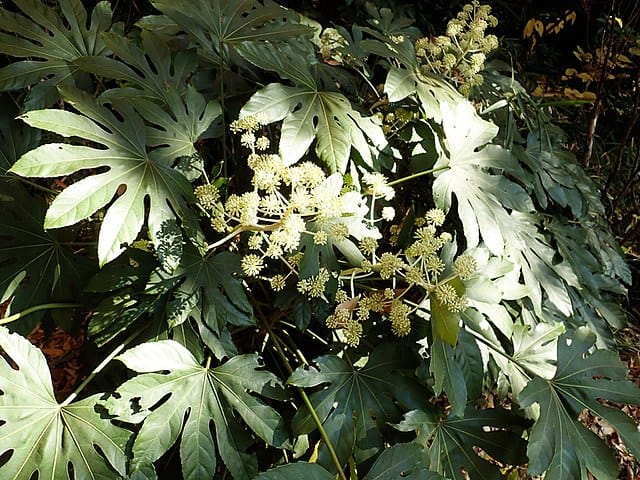
Fatsia japonica, also known as the Japanese aralia or paperplant, is a striking and distinctive evergreen shrub that can be a valuable addition to many landscaping designs. This plant is renowned for its large, deeply lobed leaves that can grow up to 12 inches in diameter, creating a bold and dramatic visual impact.
One of the key features that sets the fatsia japonica apart is its ability to thrive in shaded or partially shaded areas, making it an excellent choice for use in woodland gardens, under the canopy of larger trees, or in other areas where light levels may be limited. It is also highly adaptable to a range of soil conditions, from well-drained to moist, clay-based soils.
In addition to its striking foliage, the fatsia japonica also produces clusters of small, white flowers in the fall, which can be followed by black berries in the winter. These features, combined with the plant’s upright, multi-stemmed habit, make it a versatile choice for use as a focal point, in mixed borders, or as part of a larger planting scheme.
Fatsia japonicas are particularly well-suited for use in shaded or partially shaded areas, where their large, tropical-looking leaves can provide a striking contrast to the surrounding plants. They can also be incorporated into more formal landscaping designs, where their unique features can complement the overall aesthetic.
Photinias
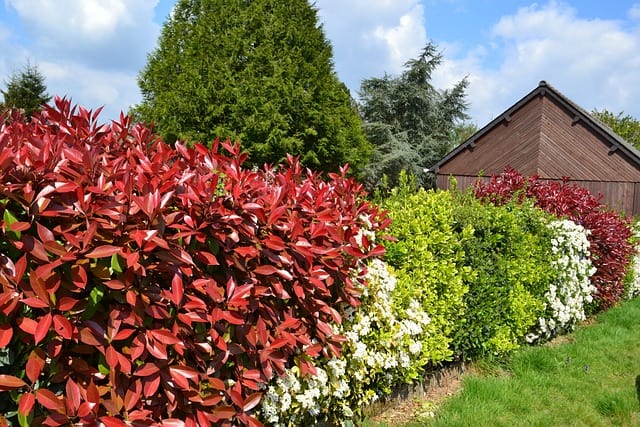
Photinias are a group of evergreen shrubs that are renowned for their striking foliage, which can range from deep green to vibrant shades of red, orange, and pink, depending on the cultivar. These versatile plants can be a valuable addition to many landscaping designs, offering a captivating display of color and texture throughout the year.
One of the key features that sets photinias apart is their ability to thrive in a wide range of soil conditions, from well-drained to heavy clay soils, and their tolerance for full sun to partial shade. This adaptability makes them a practical choice for a variety of garden settings, from formal landscaping designs to more naturalistic plantings.
In addition to their vibrant foliage, photinias also produce clusters of small, white flowers in the spring, which can be followed by red berries in the fall. These features, combined with the plant’s compact, upright habit, make it a versatile choice for use as a hedge, in mixed borders, or as a standalone specimen.
Photinias are particularly well-suited for use in landscaping designs where a bold, eye-catching element is desired. Their striking foliage can provide a dramatic contrast to the
Daphne Odora
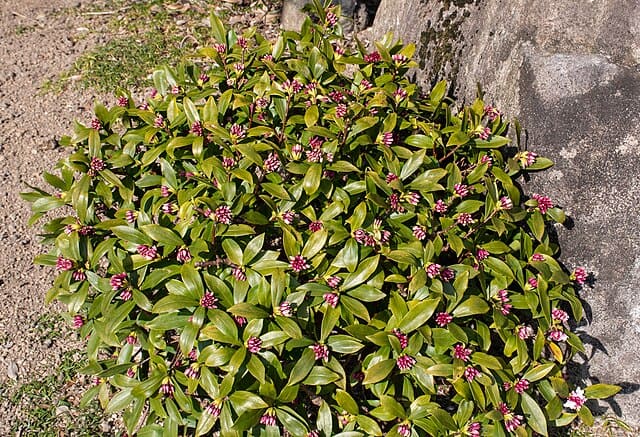
Daphne odora, also known as the winter daphne or fragrant daphne, is a captivating evergreen shrub that can be a valuable addition to many landscaping designs. This plant is renowned for its intensely fragrant, pinkish-white flowers that bloom in the late winter or early spring, often before the foliage emerges, creating a stunning and aromatic display.
One of the standout features of the Daphne odora is its ability to thrive in partial shade to full sun conditions, making it a practical choice for a variety of garden settings. It is also highly adaptable to a range of soil types, from well-drained to moist, acidic soils, further expanding its versatility in the landscape.
In addition to its captivating flowers, the Daphne odora also offers year-round interest through its attractive, evergreen foliage that can range in color from deep green to variegated patterns of green and cream. The plant’s compact, mounding habit and relatively small stature also make it an excellent choice for use as a foundation plant, in mixed borders, or as part of a rock garden.
Daphne odoras are particularly well-suited for use in woodland gardens or shaded areas, where their fragrant blooms can provide a delightful contrast to the surrounding plants. They can also be incorporated into more formal landscaping designs, where their unique features can complement the overall aesthetic.
Japanese Pieris (Pieris japonica)

Japanese pieris, also known as the lily-of-the-valley shrub, is a stunning and versatile evergreen shrub that can be a valuable addition to many landscaping designs. This plant is renowned for its clusters of delicate, bell-shaped flowers that bloom in the early spring, often in shades of white, pink, or red, creating a captivating display.
One of the key features that sets the Japanese pieris apart is its ability to thrive in partial shade to full sun conditions, making it a practical choice for a variety of garden settings. It is also highly adaptable to a range of soil types, from well-drained to moist, acidic soils, further expanding its versatility in the landscape.
In addition to its showy flowers, the Japanese pieris also offers year-round interest through its attractive, evergreen foliage that can range in color from deep green to bronze or reddish hues, depending on the cultivar. The plant’s compact, upright habit and relatively small stature also make it an excellent choice for use as a foundation plant, in mixed borders, or as part of a woodland garden.
Japanese pieris are particularly well-suited for use in shaded or partially shaded areas, where their delicate blooms and vibrant foliage can provide a striking contrast to the surrounding plants. They can also be incorporated into more formal landscaping designs, where their unique features can complement the overall aesthetic.
Siberian Carpet Cypress (Microbiota decussata)
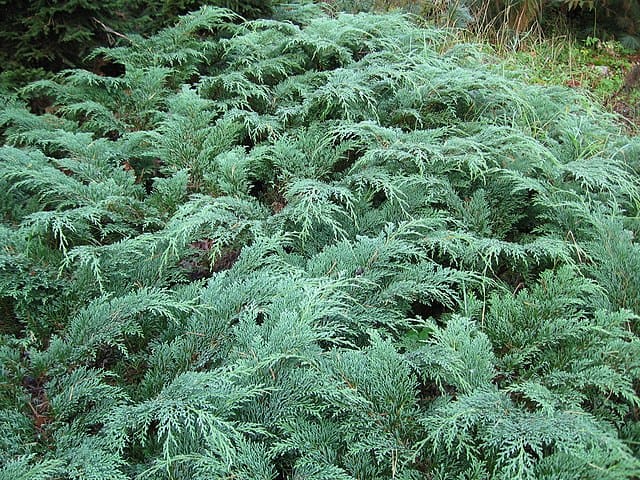
Siberian carpet cypress, also known as the Russian cypress or Siberian cypress, is a unique and versatile evergreen groundcover that can be a valuable addition to many landscaping designs. This plant is renowned for its dense, low-growing habit and its ability to form a lush, carpet-like ground cover that can provide year-round interest and texture.
One of the standout features of the Siberian carpet cypress is its adaptability to a wide range of soil conditions, from well-drained to moist, and its tolerance for full sun to partial shade. This versatility makes it a practical choice for a variety of garden settings, from formal landscaping designs to more naturalistic plantings.
Juniper ‘Blue Star’ (Juniperus squamata ‘Blue Star’)
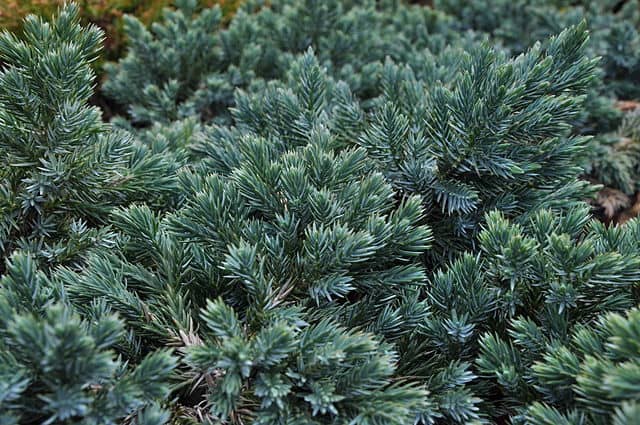
Juniper ‘Blue Star’ is a stunning and versatile evergreen shrub that can be a valuable addition to many landscaping designs. This cultivar of the Juniperus squamata, or Himalayan juniper, is renowned for its distinctive, blue-green foliage that takes on a captivating, silvery-blue hue in the winter months, creating a striking visual contrast throughout the year.
One of the key features that sets the Juniper ‘Blue Star’ apart is its compact, mounding habit, which can reach up to 3 feet in height and spread, making it an excellent choice for use as a groundcover, in rock gardens, or as a low-growing border plant. It is also highly adaptable to a wide range of soil conditions, from well-drained to dry, and can tolerate full sun to partial shade, further expanding its versatility in the landscape.
In addition to its striking foliage, the Juniper ‘Blue Star’ also offers year-round interest through its ability to maintain its vibrant color throughout the seasons. This makes it an excellent choice for use in winter gardens or as a focal point in more formal landscaping designs.
Juniper ‘Blue Star’ is particularly well-suited for use in xeriscape or drought-tolerant gardens, where its low-maintenance and water-wise nature can be an asset. It can also be incorporated into more naturalistic plantings, where its unique features can complement the surrounding plants.
Yew ‘Densiformis’ (Taxus media ‘Densiformis’)

Yew ‘Densiformis’, also known as the dense yew or compact yew, is a versatile and low-growing evergreen shrub that can be a valuable addition to many landscaping designs. This cultivar of the Taxus media, or English yew, is renowned for its dense, compact habit and its ability to maintain a tidy, manicured appearance with minimal maintenance.
One of the standout features of the Yew ‘Densiformis’ is its adaptability to a wide range of soil conditions, from well-drained to moist, and its tolerance for full sun to partial shade. This versatility makes it a practical choice for a variety of garden settings, from formal landscaping designs to more naturalistic plantings.
In addition to its compact habit, the Yew ‘Densiformis’ also offers year-round interest through its attractive, deep green foliage that can take on a bronze or reddish hue in the winter months. This, combined with the plant’s ability to be easily shaped and maintained through pruning, makes it an excellent choice for use as a low hedge, in foundation plantings, or as part of a mixed border.
Yew ‘Densiformis’ is particularly well-suited for use in formal or traditional landscaping designs, where its tidy, manicured appearance can complement the overall aesthetic. It can also be incorporated into more naturalistic plantings, where its unique features can provide a striking contrast to the surrounding plants.
Dwarf Norway Spruce (Picea abies ‘Little Gem’)

Dwarf Norway Spruce, also known as the ‘Little Gem’ Norway spruce, is a compact and slow-growing evergreen tree that can be a valuable addition to many landscaping designs. This cultivar of the Picea abies, or Norway spruce, is renowned for its dense, pyramidal habit and its ability to maintain a tidy, uniform appearance with minimal maintenance.
One of the key features that sets the Dwarf Norway Spruce apart is its adaptability to a wide range of soil conditions, from well-drained to moist, and its tolerance for full sun to partial shade. This versatility makes it a practical choice for a variety of garden settings, from formal landscaping designs to more naturalistic plantings.
Japanese Barberry (Berberis thunbergii)
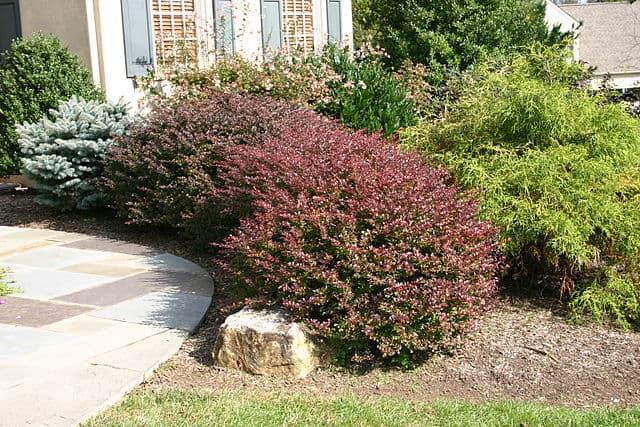
Japanese barberry is a versatile and hardy shrub that can be a valuable addition to many landscaping designs. This plant is renowned for its distinctive foliage, which can range from deep green to vibrant shades of red, orange, and purple, depending on the cultivar and the season.
One of the standout features of the Japanese barberry is its adaptability to a wide range of soil conditions, from well-drained to dry, and its tolerance for full sun to partial shade. This versatility makes it a practical choice for a variety of garden settings, from formal landscaping designs to more naturalistic plantings.
In addition to its striking foliage, the Japanese barberry also produces small, yellow flowers in the spring, which can be followed by red berries in the fall. These features, combined with the plant’s compact, mounding habit, make it a versatile choice for use as a foundation plant, in mixed borders, or as a standalone specimen.
Japanese barberries are particularly well-suited for use in low-maintenance or drought-tolerant gardens, where their hardy nature and water-wise characteristics can be an asset. They can also be incorporated into more formal landscaping designs, where their unique features can complement the overall aesthetic.
Red Twig Dogwood (Cornus alba)

Red Twig Dogwood, also known as the Siberian dogwood, is a striking and versatile shrub that can be a valuable addition to many landscaping designs. This plant is renowned for its vibrant, red stems that provide a captivating visual contrast throughout the year, particularly in the winter months when the foliage has dropped.
One of the key features that sets the Red Twig Dogwood apart is its adaptability to a wide range of soil conditions, from moist to well-drained, and its tolerance for full sun to partial shade. This versatility makes it a practical choice for a variety of garden settings, from formal landscaping designs to more naturalistic plantings.
In addition to its striking stems, the Red Twig Dogwood also produces clusters of small, white flowers in the spring, which can be followed by white or blue berries in the fall. These features, combined with the plant’s upright, multi-stemmed habit, make it a versatile choice for use as a focal point, in mixed borders, or as part of a larger planting scheme.
Red Twig Dogwoods are particularly well-suited for use in winter gardens or in areas where year-round visual interest is desired. Their vibrant stems can provide a striking contrast to the surrounding plants and can be further accentuated through strategic placement or pruning.
Persian Shield (Strobilanthes dyerianus)
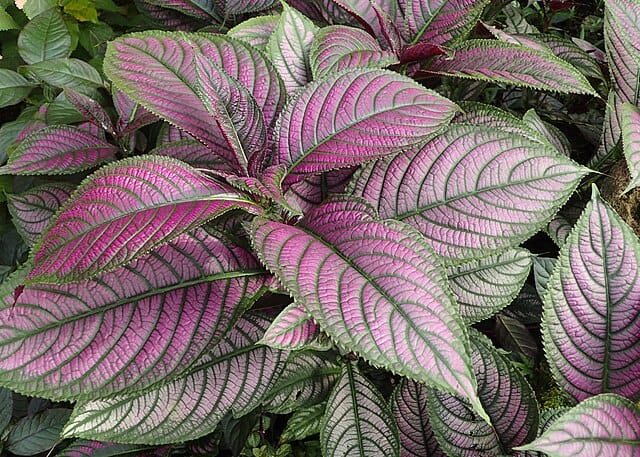
Persian shield is a striking and unique foliage plant that can be a valuable addition to many landscaping designs. This plant is renowned for its distinctive, iridescent leaves that can range in color from deep purple to shimmering shades of green and silver, creating a captivating visual display.
One of the standout features of the Persian shield is its ability to thrive in partial shade to full sun conditions, making it a practical choice for a variety of garden settings. It is also highly adaptable to a range of soil types, from well-drained to moist, further expanding its versatility in the landscape.
In addition to its striking foliage, the Persian shield also produces small, purple flowers in the summer, which can add an additional layer of visual interest to the plant. Its compact, upright habit also makes it an excellent choice for use as a focal point, in mixed borders, or as part of a container planting.
Persian shields are particularly well-suited for use in tropical or subtropical-inspired gardens, where their bold, iridescent leaves can create a striking contrast to the surrounding plants. They can also be incorporated into more formal landscaping designs, where their unique features can complement the overall aesthetic.
Heavenly Bamboo (Nandina domestica)
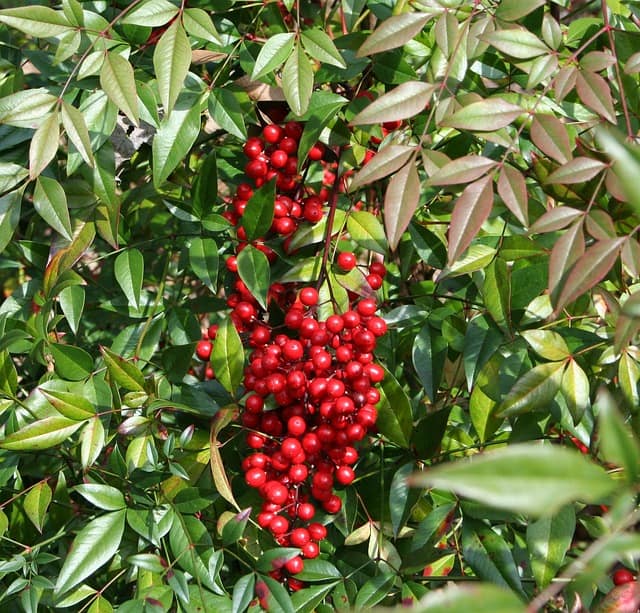
Heavenly Bamboo, also known as the sacred bamboo or nandina, is a versatile and eye-catching shrub that can be a valuable addition to many landscaping designs. This plant is renowned for its distinctive, bamboo-like foliage that can take on a range of vibrant colors throughout the seasons, from deep green to fiery shades of red, orange, and purple.
One of the key features that sets the Heavenly Bamboo apart is its adaptability to a wide range of soil conditions, from well-drained to moist, and its tolerance for full sun to partial shade. This versatility makes it a practical choice for a variety of garden settings, from formal landscaping designs to more naturalistic plantings.
In addition to its striking foliage, the Heavenly Bamboo also produces clusters of small, white flowers in the spring, which can be followed by red berries in the fall. These features, combined with the plant’s upright, clumping habit, make it a versatile choice for use as a focal point, in mixed borders, or as part of a larger planting scheme.
Heavenly Bamboos are particularly well-suited for use in Asian-inspired gardens or in areas where year-round visual interest is desired. Their vibrant foliage can provide a captivating contrast to the surrounding plants, and their compact size makes them a practical choice for use in smaller garden spaces.
American Beautyberry (Callicarpa americana)
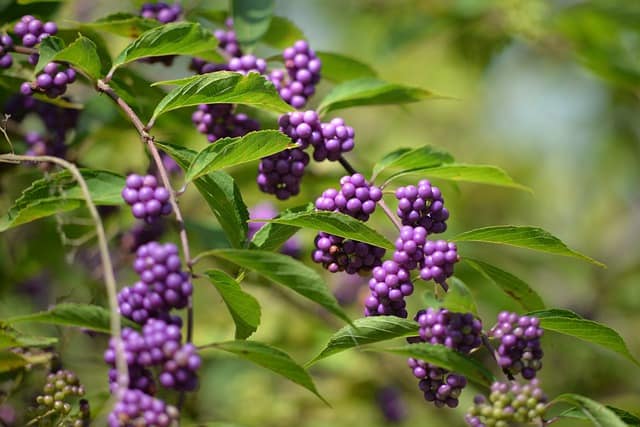
American Beautyberry is a striking and unique shrub that can be a valuable addition to many landscaping designs. This plant is renowned for its vibrant, purple berries that emerge in the fall, creating a captivating visual display that can last well into the winter months.
One of the standout features of the American Beautyberry is its adaptability to a wide range of soil conditions, from well-drained to moist, and its tolerance for full sun to partial shade. This versatility makes it a practical choice for a variety of garden settings, from formal landscaping designs to more naturalistic plantings.
In addition to its striking berries, the American Beautyberry also produces small, pink or white flowers in the summer, which can add an additional layer of visual interest to the plant. Its arching, multi-stemmed habit also makes it an excellent choice for use as a focal point, in mixed borders, or as part of a larger planting scheme.
American Beautyberries are particularly well-suited for use in wildlife-friendly gardens, as their berries can provide a valuable food source for birds and other small animals. They can also be incorporated into more formal landscaping designs, where their unique features can complement the overall aesthetic.
Boxwood

Boxwood is a classic and versatile evergreen shrub that can be a valuable addition to many landscaping designs. This plant is renowned for its dense, compact habit and its ability to be easily shaped and maintained through pruning, making it a popular choice for use in formal gardens, hedges, and topiary.
One of the key features that sets boxwood apart is its adaptability to a wide range of soil conditions, from well-drained to moist, and its tolerance for full sun to partial shade. This versatility makes it a practical choice for a variety of garden settings, from formal landscaping designs to more naturalistic plantings.
In addition to its tidy, manicured appearance, boxwood also offers year-round interest through its attractive, deep green foliage that can take on a bronze or reddish hue in the winter months. This, combined with the plant’s compact habit and its ability to be easily shaped, makes it an excellent choice for use as a foundation plant, in mixed borders, or as part of a larger planting scheme.
Boxwoods are particularly well-suited for use in formal or traditional landscaping designs, where their tidy, uniform appearance can complement the overall aesthetic. They can also be incorporated into more naturalistic plantings, where their unique features can provide a striking
Liriope
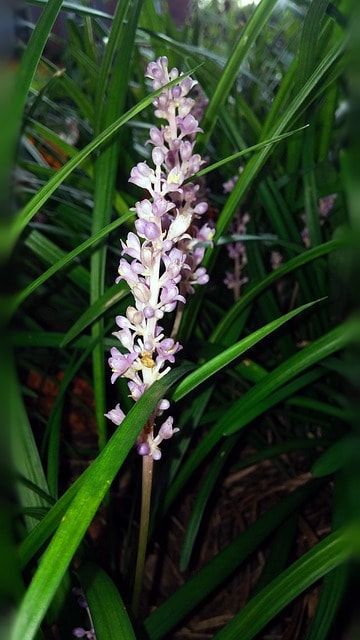
Liriope, also known as lily turf or monkey grass, is a versatile and low-maintenance perennial that can be a valuable addition to many landscaping designs. This plant is renowned for its dense, grass-like foliage that can range in color from deep green to variegated shades, creating a striking visual contrast in the garden.
One of the standout features of liriope is its adaptability to a wide range of soil conditions, from well-drained to moist, and its tolerance for full sun to partial shade. This versatility makes it a practical choice for a variety of garden settings, from formal landscaping designs to more naturalistic plantings.
In addition to its attractive foliage, liriope also produces clusters of small, purple or white flowers in the late summer or fall, which can add an additional layer of visual interest to the plant. Its compact, clumping habit also makes it an excellent choice for use as a groundcover, in edging, or as part of a mixed border.
Liriope is particularly well-suited for use in low-maintenance or drought-tolerant gardens, where its hardy nature and water-wise characteristics can be an asset. It can also be incorporated into more formal landscaping designs, where its tidy appearance can complement the overall aesthetic.
Hosta
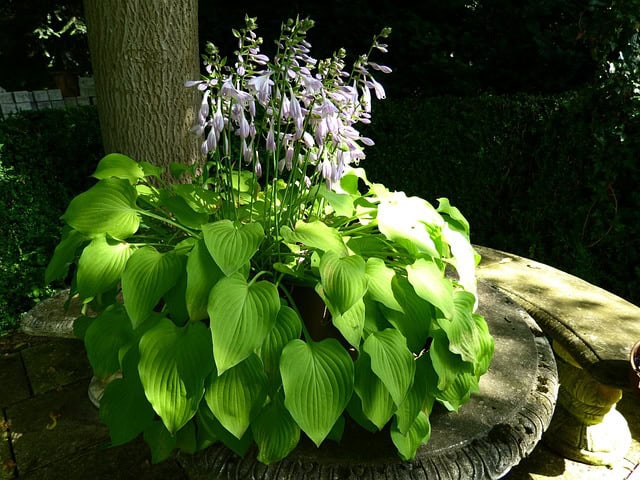
Hosta, also known as the plantain lily, is a versatile and shade-loving perennial that can be a valuable addition to many landscaping designs. This plant is renowned for its distinctive, broad leaves that can range in color from deep green to variegated shades, creating a striking visual contrast in the garden.
One of the key features that sets hosta apart is its adaptability to a wide range of soil conditions, from well-drained to moist, and its tolerance for partial to full shade. This versatility makes it a practical choice for use in shaded areas or as part of a mixed border in a more formal landscaping design.
In addition to its attractive foliage, hosta also produces clusters of small, bell-shaped flowers in the summer, which can add an additional layer of visual interest to the plant. Its compact, clumping habit also makes it an excellent choice for use as a groundcover or in container plantings.
Hostas are particularly well-suited for use in shade gardens or in areas where other plants may struggle to thrive. They can also be incorporated into more formal landscaping designs, where their unique features can complement the overall aesthetic.
Blueberry
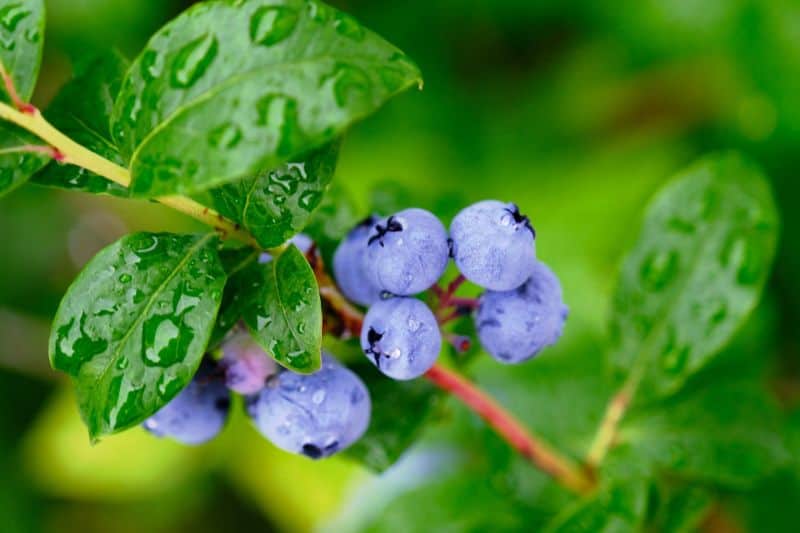
Blueberry is a versatile and productive fruit-bearing shrub that can be a valuable addition to many landscaping designs. This plant is renowned for its distinctive, blue-green foliage that can take on vibrant shades of red, orange, and purple in the fall, creating a captivating visual display.
One of the standout features of blueberry is its adaptability to a wide range of soil conditions, from well-drained to moist, and its tolerance for full sun to partial shade. This versatility makes it a practical choice for a variety of garden settings, from formal landscaping designs to more naturalistic plantings.
In addition to its striking foliage, blueberry also produces clusters of small, white flowers in the spring, which can be followed by a bountiful harvest of delicious, blue-hued berries in the summer. These features, combined with the plant’s compact, mounding habit, make it a versatile choice for use as a focal point, in mixed borders, or as part of a larger edible landscaping scheme.
Blueberries are particularly well-suited for use in edible gardens or in areas where year-round visual interest is desired. Their vibrant foliage and bountiful fruit production can provide a captivating contrast to the surrounding plants, while also offering a valuable food source for both humans and wildlife.
Caladium
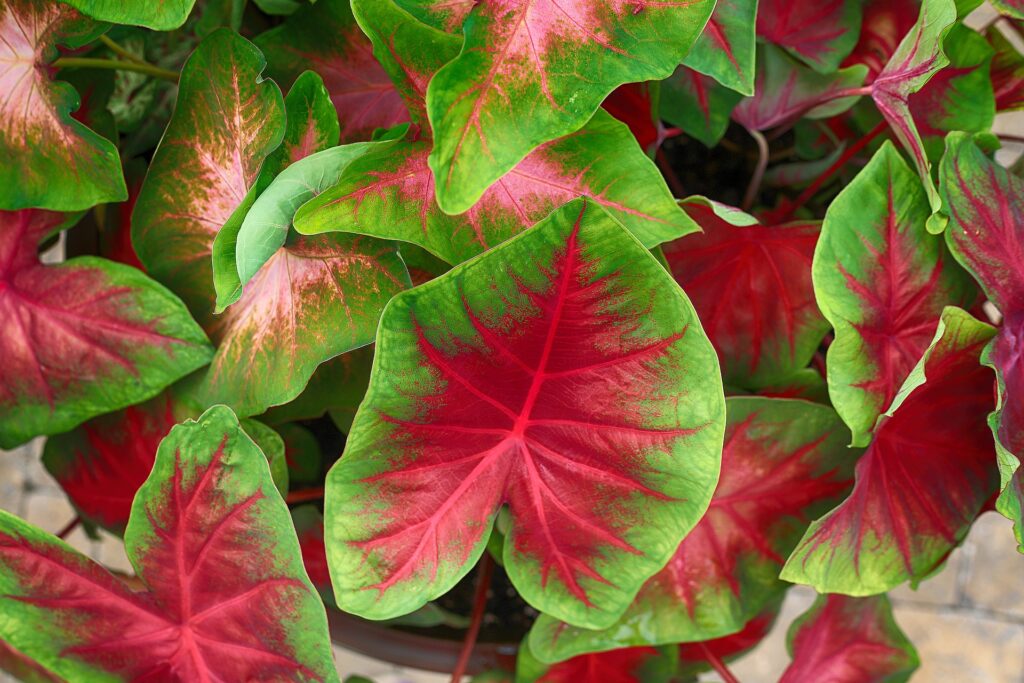
Caladium is a vibrant and eye-catching foliage plant that can be a valuable addition to many landscaping designs. This tropical perennial is renowned for its distinctive, heart-shaped leaves that can display a stunning array of colors, including shades of red, pink, white, and green.
One of the standout features of caladium is its ability to thrive in partial to full shade, making it a practical choice for use in shaded areas of the garden where other plants may struggle. Its adaptability to a range of soil conditions, from well-drained to moist, further expands its versatility in the landscape.
In addition to its striking foliage, caladium also produces small, inconspicuous flowers that can add a subtle touch of interest to the plant. Its compact, mounding habit also makes it an excellent choice for use in container plantings, as a groundcover, or as part of a mixed border.
Caladiums are particularly well-suited for use in tropical or subtropical-inspired gardens, where their bold, vibrant leaves can create a captivating focal point. They can also be incorporated into more formal landscaping designs, where their unique features can complement the overall aesthetic.
Dianthus

Dianthus, also known as pinks or carnations, is a versatile and fragrant perennial that can be a valuable addition to many landscaping designs. This plant is renowned for its delicate, often-ruffled flowers that can range in color from vibrant pinks and reds to soft pastels and whites.
One of the key features that sets dianthus apart is its adaptability to a wide range of soil conditions, from well-drained to moist, and its tolerance for full sun to partial shade. This versatility makes it a practical choice for a variety of garden settings, from formal landscaping designs to more naturalistic plantings.
In addition to its striking flowers, dianthus also offers a delightful, spicy-sweet fragrance that can add an extra layer of sensory appeal to the garden. Its compact, mounding habit also makes it an excellent choice for use in edging, as a groundcover, or in container plantings.
Dianthus are particularly well-suited for use in cottage-style or informal gardens, where their delicate blooms and fragrance can create a charming, romantic atmosphere. They can also be incorporated into more formal landscaping designs, where their unique features can complement the overall aesthetic.
Zinnia
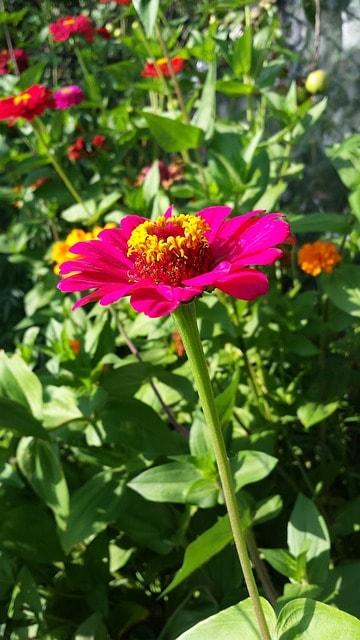
Zinnia is a vibrant and easy-to-grow annual that can be a valuable addition to many landscaping designs. This plant is renowned for its bold, daisy-like flowers that can range in color from bright reds and oranges to soft pastels and bicolors, creating a captivating visual display.
One of the standout features of zinnia is its adaptability to a wide range of soil conditions, from well-drained to moist, and its tolerance for full sun. This versatility makes it a practical choice for a variety of garden settings, from formal landscaping designs to more naturalistic plantings.
In addition to its striking flowers, zinnia also offers a long blooming season, with flowers typically appearing from mid-summer through the first frost. Its compact, bushy habit also makes it an excellent choice for use in cutting gardens, as a border plant, or in container plantings.
Zinnias are particularly well-suited for use in pollinator-friendly gardens, as their nectar-rich flowers can attract a variety of beneficial insects, such as butterflies and hummingbirds. They can also be incorporated into more formal landscaping designs, where their bold, vibrant colors can create a striking contrast to the surrounding plants.
Switchgrass (Panicum virgatum)
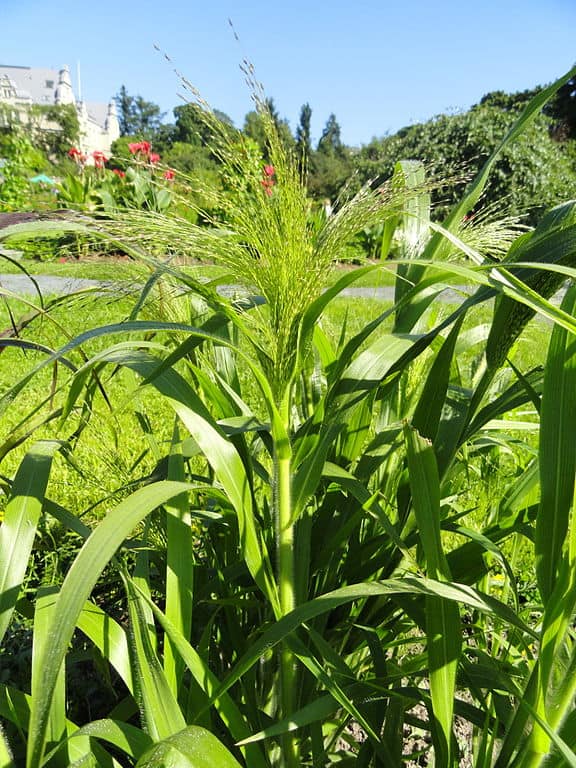
Switchgrass is a versatile and low-maintenance ornamental grass that can be a valuable addition to many landscaping designs. This native North American species is renowned for its upright, clumping habit and its distinctive, blue-green foliage that can take on vibrant shades of red, orange, and purple in the fall.
One of the key features that sets switchgrass apart is its adaptability to a wide range of soil conditions, from well-drained to moist, and its tolerance for full sun to partial shade. This versatility makes it a practical choice for a variety of garden settings, from formal landscaping designs to more naturalistic plantings.
In addition to its striking foliage, switchgrass also produces airy, feathery flower plumes in the late summer or fall, which can add an extra layer of visual interest to the plant. Its compact, upright habit also makes it an excellent choice for use as a focal point, in mixed borders, or as part of a larger ornamental grass planting.
Switchgrass is particularly well-suited for use in low-maintenance or drought-tolerant gardens, where its hardy nature and water-wise characteristics can be an asset. It can also be incorporated into more formal landscaping designs, where its unique features can complement the overall aesthetic.
Fountain Grass (Pennisetum)
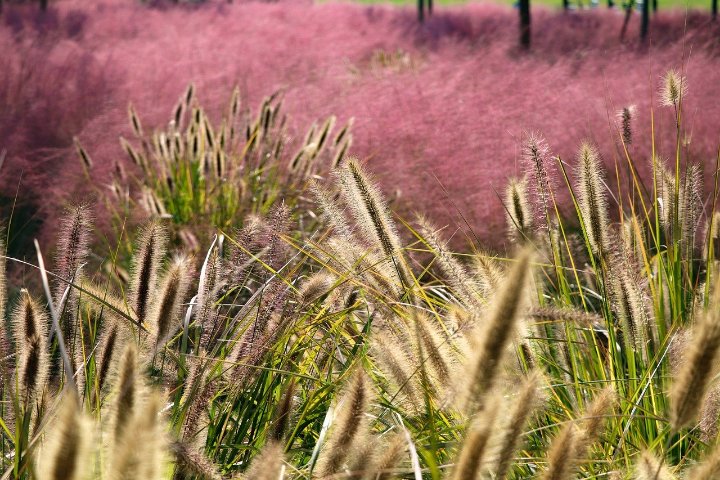
Fountain grass is a graceful and eye-catching ornamental grass that can be a valuable addition to many landscaping designs. This genus is renowned for its arching, cascading habit and its distinctive, bottlebrush-like flower plumes that can range in color from pink and purple to white and tan.
One of the standout features of fountain grass is its adaptability to a wide range of soil conditions, from well-drained to moist, and its tolerance for full sun to partial shade. This versatility makes it a practical choice for a variety of garden settings, from formal landscaping designs to more naturalistic plantings.
In addition to its striking flower plumes, fountain grass also offers year-round visual interest through its lush, green foliage that can take on warm, golden hues in the fall. Its compact, mounding habit also makes it an excellent choice for use as a groundcover, in mixed borders, or as part of a larger ornamental grass planting.
Fountain grasses are particularly well-suited for use in Mediterranean-inspired or drought-tolerant gardens, where their water-wise characteristics and graceful appearance can create a captivating focal point. They can also be incorporated into more formal landscaping designs, where their unique features can complement the overall aesthetic.
Daphne
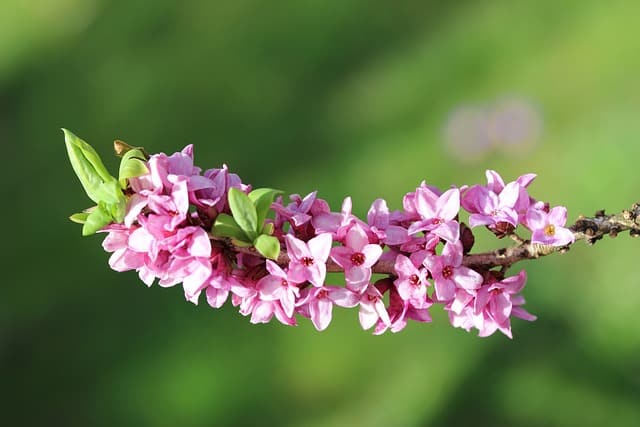
Daphne is a fragrant and evergreen shrub that can be a valuable addition to many landscaping designs. This plant is renowned for its delicate, often-clustered flowers that can range in color from vibrant pinks and purples to soft whites, creating a captivating visual and olfactory display.
One of the key features that sets daphne apart is its adaptability to a range of soil conditions, from well-drained to moist, and its tolerance for partial shade. This versatility makes it a practical choice for use in shaded areas or as part of a mixed border in a more formal landscaping design.
In addition to its striking flowers, daphne also offers a delightful, often-spicy fragrance that can add an extra layer of sensory appeal to the garden. Its compact, mounding habit also makes it an excellent choice for use as a foundation plant, in rock gardens, or in container plantings.
Daphnes are particularly well-suited for use in cottage-style or informal gardens, where their delicate blooms and fragrance can create a charming, romantic atmosphere. They can also be incorporated into more formal landscaping designs, where their unique features can complement the overall aesthetic.
Impatiens
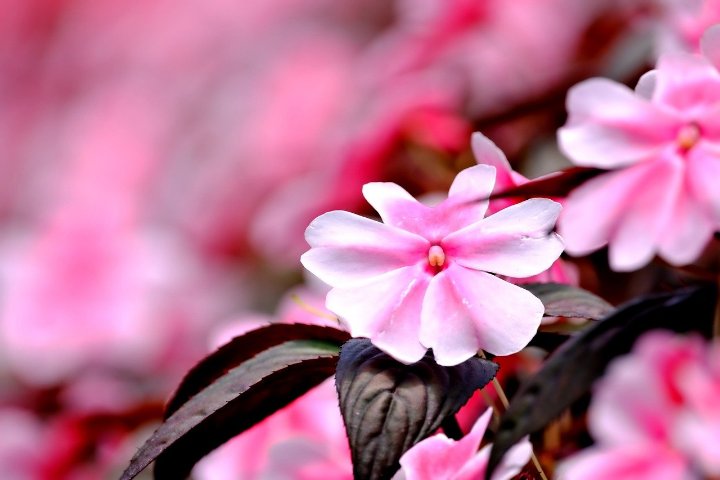
Impatiens, also known as busy Lizzie or touch-me-not, is a vibrant and versatile annual that can be a valuable addition to many landscaping designs. This plant is renowned for its abundant, brightly colored flowers that can range from shades of pink and red to purple, orange, and white, creating a captivating visual display.
One of the standout features of impatiens is its ability to thrive in partial to full shade, making it a practical choice for use in shaded areas of the garden where other plants may struggle. Its adaptability to a range of soil conditions, from well-drained to moist, further expands its versatility in the landscape.
In addition to its striking flowers, impatiens also offer a compact, mounding habit that makes them an excellent choice for use as a groundcover, in container plantings, or as part of a mixed border. Their continuous blooming throughout the growing season can also provide a long-lasting source of color and interest in the garden.
Impatiens are particularly well-suited for use in shade gardens, where their vibrant flowers can create a focal point or add a pop of color to the surrounding foliage. They can also be incorporated into more formal landscaping designs, where their unique features can complement the overall aesthetic.
Bleeding Heart (Dicentra)

Bleeding heart is a delicate and eye-catching perennial that can be a valuable addition to many landscaping designs. This plant is renowned for its distinctive, heart-shaped flowers that dangle gracefully from arching stems, creating a captivating visual display.
One of the key features that sets bleeding heart apart is its adaptability to partial to full shade, making it a practical choice for use in shaded areas of the garden. Its tolerance for a range of soil conditions, from well-drained to moist, further expands its versatility in the landscape.
In addition to its striking flowers, bleeding heart also offers a compact, mounding habit that can make it an excellent choice for use as a groundcover, in mixed borders, or in container plantings. Its delicate, fern-like foliage can also provide an additional layer of visual interest throughout the growing season.
Bleeding hearts are particularly well-suited for use in cottage-style or informal gardens, where their delicate blooms and graceful appearance can create a charming, romantic atmosphere. They can also be incorporated into more formal landscaping designs, where their unique features can complement the overall aesthetic.
Lily of the Valley (Convallaria)
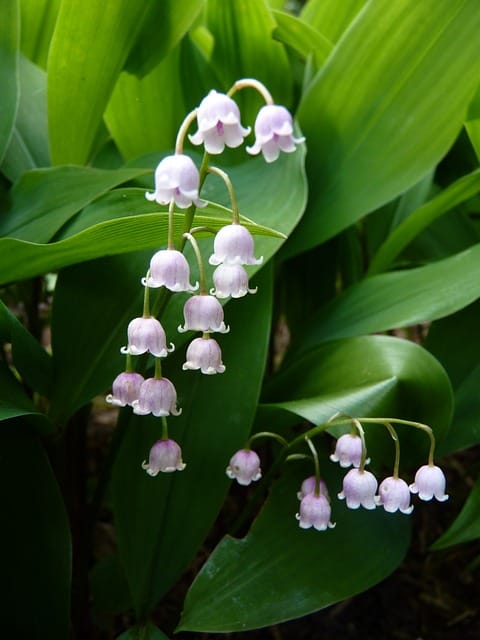
Lily of the Valley is a fragrant and delicate perennial that can be a valuable addition to many landscaping designs. This plant is renowned for its distinctive, bell-shaped flowers that hang in clusters, creating a captivating visual and olfactory display.
One of the standout features of lily of the valley is its adaptability to partial to full shade, making it a practical choice for use in shaded areas of the garden. Its tolerance for a range of soil conditions, from well-drained to moist, further expands its versatility in the landscape.
In addition to its striking flowers, lily of the valley also offers a compact, spreading habit that can make it an excellent choice for use as a groundcover or in mixed borders. Its glossy, green foliage can also provide an additional layer of visual interest throughout the growing season.
Lily of the Valley is particularly well-suited for use in cottage-style or informal gardens, where its delicate blooms and fragrance can create a charming, nostalgic atmosphere. They can also be incorporated into more formal landscaping designs, where their unique features can complement the overall aesthetic.
Hellebore (Helleborus)
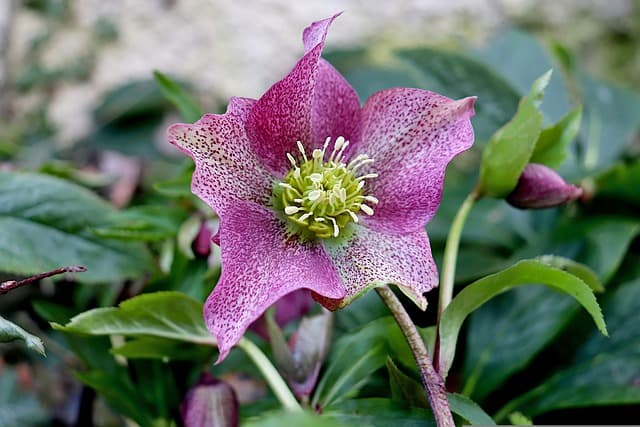
Hellebore, also known as the Christmas rose or Lenten rose, is a versatile and long-blooming perennial that can be a valuable addition to many landscaping designs. This plant is renowned for its distinctive, cup-shaped flowers that can range in color from white and pink to deep purple and green, creating a captivating visual display.
One of the key features that sets hellebore apart is its ability to bloom as early as late winter or early spring, providing a welcome burst of color in the garden when other plants are still dormant. Its adaptability to partial to full shade, as well as its tolerance for a range of soil conditions, further expands its versatility in the landscape.
In addition to its striking flowers, hellebore also offers evergreen, leathery foliage that can provide year-round interest in the garden. Its compact, mounding habit also makes it an excellent choice for use as a groundcover, in mixed borders, or in container plantings.
Hellebores are particularly well-suited for use in shade gardens, where their early blooms can create a focal point or add a touch of elegance to the surrounding foliage. They can also be incorporated into more formal landscaping designs, where their unique features can complement the overall aesthetic.
Daylily (Hemerocallis)
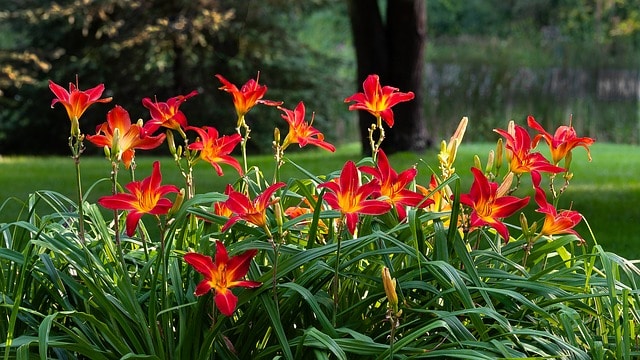
Daylily is a versatile and long-blooming perennial that can be a valuable addition to many landscaping designs. This plant is renowned for its vibrant, trumpet-shaped flowers that can range in color from bold reds and oranges to soft pastels and bicolors, creating a captivating visual display.
One of the standout features of daylily is its adaptability to a wide range of soil conditions, from well-drained to moist, and its tolerance for full sun to partial shade. This versatility makes it a practical choice for a variety of garden settings, from formal landscaping designs to more naturalistic plantings.
In addition to its striking flowers, daylily also offers a compact, clumping habit that can make it an excellent choice for use as a groundcover, in mixed borders, or as part of a larger perennial planting. Its long blooming season, which can extend from early summer through the fall, can also provide a continuous source of color and interest in the garden.
Daylilies are particularly well-suited for use in low-maintenance or drought-tolerant gardens, where their hardy nature and water-wise characteristics can be an asset. They can also be incorporated into more formal landscaping designs, where their unique features can complement the overall aesthetic.
Nandina (Nandina domestica)

Nandina, also known as heavenly bamboo, is an evergreen shrub that can be a valuable addition to many landscaping designs. This plant is renowned for its distinctive, bamboo-like foliage that can take on vibrant shades of red, orange, and purple, particularly in the fall and winter months, creating a captivating visual display.
One of the key features that sets nandina apart is its adaptability to a range of soil conditions, from well-drained to moist, and its tolerance for full sun to partial shade. This versatility makes it a practical choice for use in a variety of garden settings, from formal landscaping designs to more naturalistic plantings.
In addition to its striking foliage, nandina also produces clusters of small, white flowers in the spring, followed by clusters of red berries in the fall and winter. Its compact, upright habit also makes it an excellent choice for use as a foundation plant, in mixed borders, or as part of a larger shrub planting.
Nandinas are particularly well-suited for use in Asian-inspired or contemporary garden designs, where their unique features can create a focal point or complement the overall aesthetic. They can also be incorporated into more traditional landscaping designs, where their adaptability and year-round interest can be an asset.





